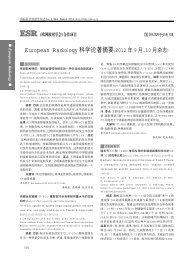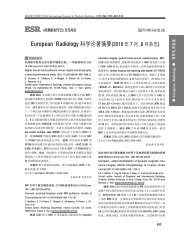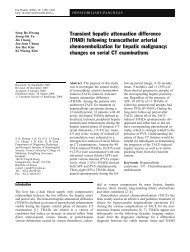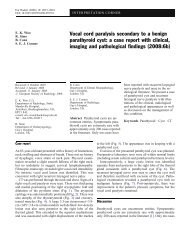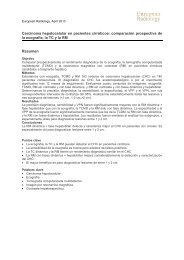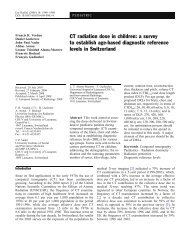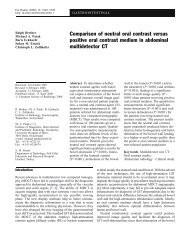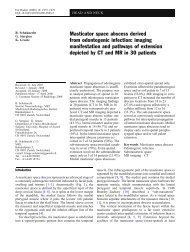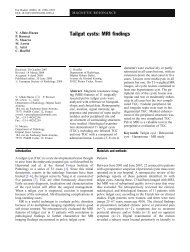Value of comprehensive renal ultrasound in children with acute ...
Value of comprehensive renal ultrasound in children with acute ...
Value of comprehensive renal ultrasound in children with acute ...
Create successful ePaper yourself
Turn your PDF publications into a flip-book with our unique Google optimized e-Paper software.
Eur Radiol (2008) 18: 2981–2989<br />
DOI 10.1007/s00330-008-1081-z PEDIATRIC<br />
Peter Brader<br />
Michael Riccabona<br />
Thomas Schwarz<br />
Ursula Seebacher<br />
Ekkehard R<strong>in</strong>g<br />
Received: 7 November 2007<br />
Revised: 9 May 2008<br />
Accepted: 17 May 2008<br />
Published onl<strong>in</strong>e: 19 July 2008<br />
# European Society <strong>of</strong> Radiology 2008<br />
P. Brader . M. Riccabona (*)<br />
Division <strong>of</strong> Pediatric Radiology,<br />
Department <strong>of</strong> Radiology,<br />
Medical University Graz,<br />
Auenbruggerplatz 9,<br />
A-8036 Graz, Austria<br />
e-mail: michael.riccabona@<br />
kl<strong>in</strong>ikum-graz.at<br />
Tel.: +43-316-3854202<br />
Fax: +43-316-3854299<br />
T. Schwarz<br />
Division <strong>of</strong> Nuclear Medic<strong>in</strong>e,<br />
Department <strong>of</strong> Radiology,<br />
Medical University Graz,<br />
Auenbruggerplatz 9,<br />
A-8036 Graz, Austria<br />
U. Seebacher<br />
Department <strong>of</strong> Pediatric Surgery,<br />
Medical University Graz,<br />
Auenbruggerplatz 34,<br />
A-8036 Graz, Austria<br />
Introduction<br />
Ur<strong>in</strong>ary tract <strong>in</strong>fection (UTI) is a common disease <strong>in</strong><br />
childhood and may cause diagnostic problems <strong>in</strong> rout<strong>in</strong>e<br />
pediatric practice [1]. Especially <strong>in</strong> neonates and <strong>in</strong>fants,<br />
there are no specific cl<strong>in</strong>ical signs or reliable symptoms;<br />
even laboratory f<strong>in</strong>d<strong>in</strong>gs may be confus<strong>in</strong>g. In older<br />
<strong>children</strong> upper UTI usually occurs <strong>with</strong> fever, whereas <strong>in</strong><br />
younger patients the differentiation <strong>of</strong> lower from upper<br />
UTI can be difficult just based on cl<strong>in</strong>ical and laboratory<br />
f<strong>in</strong>d<strong>in</strong>gs. However, early detection <strong>of</strong> <strong>renal</strong> <strong>in</strong>volvement is<br />
<strong>Value</strong> <strong>of</strong> <strong>comprehensive</strong> <strong>renal</strong> <strong>ultrasound</strong><br />
<strong>in</strong> <strong>children</strong> <strong>with</strong> <strong>acute</strong> ur<strong>in</strong>ary tract <strong>in</strong>fection<br />
for assessment <strong>of</strong> <strong>renal</strong> <strong>in</strong>volvement:<br />
comparison <strong>with</strong> DMSA sc<strong>in</strong>tigraphy<br />
and f<strong>in</strong>al diagnosis<br />
E. R<strong>in</strong>g<br />
Department <strong>of</strong> Pediatrics,<br />
Medical University Graz,<br />
Auenbruggerplatz 30,<br />
A-8036 Graz, Austria<br />
Abstract The aim <strong>of</strong> this study was to<br />
evaluate the value <strong>of</strong> <strong>comprehensive</strong><br />
<strong>renal</strong> <strong>ultrasound</strong> (US), i.e., comb<strong>in</strong><strong>in</strong>g<br />
greyscale US and amplitude-coded<br />
color Doppler sonography (aCDS), for<br />
assessment <strong>of</strong> ur<strong>in</strong>ary tract <strong>in</strong>fection<br />
(UTI) <strong>in</strong> <strong>in</strong>fants and <strong>children</strong>, compared<br />
to (1) 99m Tc DMSA sc<strong>in</strong>tigraphy<br />
and (2) f<strong>in</strong>al diagnosis. Two<br />
hundred eighty-seven <strong>children</strong> <strong>with</strong><br />
UTI underwent <strong>renal</strong> <strong>comprehensive</strong><br />
US and DMSA sc<strong>in</strong>tigraphy. The<br />
results were compared <strong>with</strong> regard to<br />
their reliability to diagnose <strong>renal</strong><br />
<strong>in</strong>volvement, us<strong>in</strong>g (1) DMSA sc<strong>in</strong>tigraphy<br />
and (2) f<strong>in</strong>al diagnosis as the<br />
gold standard. Sixty-seven <strong>children</strong><br />
cl<strong>in</strong>ically had <strong>renal</strong> <strong>in</strong>volvement.<br />
Sensitivity <strong>in</strong>creased from 84.1%<br />
us<strong>in</strong>g only aCDS to 92.1% for the<br />
comb<strong>in</strong>ed US approach, us<strong>in</strong>g DMSA<br />
sc<strong>in</strong>tigraphy as the reference standard.<br />
When correlated <strong>with</strong> the f<strong>in</strong>al diagnosis,<br />
sensitivity for DMSA sc<strong>in</strong>tigraphy<br />
was 92.5%; sensitivity for<br />
<strong>comprehensive</strong> US was 94.0%. Our<br />
data demonstrate an <strong>in</strong>creas<strong>in</strong>g sensitivity<br />
us<strong>in</strong>g the comb<strong>in</strong>ation <strong>of</strong> <strong>renal</strong><br />
greyscale US supplemented by aCDS<br />
for differentiation <strong>of</strong> upper from lower<br />
UTI. Sensitivity for DMSA and <strong>comprehensive</strong><br />
US was similar for both<br />
methods compared to the f<strong>in</strong>al diagnosis.<br />
Comprehensive US should ga<strong>in</strong><br />
a more important role <strong>in</strong> the imag<strong>in</strong>g<br />
algorithm <strong>of</strong> <strong>children</strong> <strong>with</strong> <strong>acute</strong> UTI,<br />
thereby reduc<strong>in</strong>g the radiation burden.<br />
Keywords Dimercaptosucc<strong>in</strong>ic acid<br />
sc<strong>in</strong>tigraphy . Power Doppler<br />
ultrasonography . Ur<strong>in</strong>ary tract<br />
<strong>in</strong>fection . Acute pyelonephritis .<br />
Children<br />
essential for <strong>in</strong>tensity and duration <strong>of</strong> treatment, as <strong>acute</strong><br />
pyelonephritis (aPN) may result <strong>in</strong> irreversible <strong>renal</strong><br />
damage. APN can <strong>in</strong>duce <strong>renal</strong> scars as a complication;<br />
the importance <strong>of</strong> aPN-associated risks is under debate, but<br />
long-term complications such as hypertension and chronic<br />
<strong>renal</strong> failure have to be considered [2]. Therefore, an early,<br />
reliable, and accurate as well as easily accessible imag<strong>in</strong>g<br />
method for aPN assessment may be valuable [3].<br />
Renal technetium-99m dimercaptosucc<strong>in</strong>ic acid ( 99m Tc<br />
DMSA) sc<strong>in</strong>tigraphy has been shown to be highly sensitive<br />
and specific for the diagnosis <strong>of</strong> <strong>acute</strong> <strong>in</strong>flammatory <strong>renal</strong>
2982<br />
changes [4–7]; currently DMSA sc<strong>in</strong>tigraphy is considered<br />
the gold standard (i.e., the reference <strong>in</strong>vestigation) for the<br />
diagnosis <strong>of</strong> aPN and <strong>renal</strong> scarr<strong>in</strong>g [8–10]. Contrastenhanced<br />
spiral CT has been reported to be an efficient<br />
diagnostic tool, but is reluctantly used <strong>in</strong> <strong>children</strong> due to its<br />
high radiation burden [11, 12]. Both DMSA and particularly<br />
CT studies have the disadvantage <strong>of</strong> ioniz<strong>in</strong>g radiation<br />
exposure and <strong>in</strong>travenously <strong>in</strong>jected agents. Additionally,<br />
they are relatively expensive, and DMSA is not available at<br />
night hours and dur<strong>in</strong>g the weekend <strong>in</strong> some areas. MRI is<br />
also highly effective, but the rout<strong>in</strong>e use is h<strong>in</strong>dered by the<br />
high costs, its restricted availability, and the need for<br />
sedation <strong>in</strong> small <strong>children</strong> and <strong>in</strong>fants [13].<br />
Ultrasound (US) is widely available, <strong>in</strong>expensive, and <strong>in</strong><br />
general the first imag<strong>in</strong>g study performed <strong>in</strong> <strong>children</strong> <strong>with</strong><br />
suspected UTI, though availability <strong>of</strong> reliable high-quality<br />
US is also restricted. However, greyscale US is reported to<br />
be poor <strong>in</strong> detection <strong>of</strong> <strong>renal</strong> <strong>in</strong>volvement [1]. More than a<br />
decade ago amplitude-coded color Doppler sonography<br />
(aCDS), also called “power Doppler,” was <strong>in</strong>troduced. It<br />
has a higher sensitivity to low-flow velocities even at high<br />
<strong>in</strong>solation angles (provided sufficient flow volume, as<br />
encountered <strong>in</strong> the peripheral <strong>renal</strong> parenchyma) [14].<br />
Also, aCDS has successfully been used for assessment <strong>of</strong><br />
particularly focal or segmental <strong>renal</strong> perfusion alteration<br />
[15]. Most pyelonephritic lesions have an ischemic component<br />
or exhibit associated perfusion disturbances, <strong>with</strong> a<br />
reportedly higher sensitivity <strong>of</strong> aCDS for the detection <strong>of</strong><br />
(focal) aPN [16, 17]. However, all these studies focus<br />
exclusively on the use <strong>of</strong> aCDS, not <strong>in</strong>clud<strong>in</strong>g additional<br />
<strong>in</strong>formation retrieved from greyscale US that may also be<br />
beneficial for the diagnos<strong>in</strong>g upper UTI.<br />
The aim <strong>of</strong> this retrospective analysis was to evaluate if<br />
comb<strong>in</strong><strong>in</strong>g <strong>renal</strong> greyscale US and aCDS f<strong>in</strong>d<strong>in</strong>gs may<br />
improve US potential for depiction <strong>of</strong> upper UTI <strong>in</strong> <strong>in</strong>fants<br />
and <strong>children</strong> compared to (1) DMSA sc<strong>in</strong>tigraphy and (2)<br />
f<strong>in</strong>al diagnosis.<br />
Materials and methods<br />
The picture archiv<strong>in</strong>g and communication system <strong>of</strong> our<br />
hospital was used to retrospectively identify pediatric<br />
patients <strong>with</strong> <strong>acute</strong> UTI who underwent <strong>comprehensive</strong> US<br />
(i.e., <strong>in</strong>clud<strong>in</strong>g aCDS) and DMSA for the assessment <strong>of</strong><br />
<strong>renal</strong> <strong>in</strong>volvement. Patients <strong>with</strong> congenital abnormalities,<br />
hydronephrosis, recurrent UTI, known vesico-ureteral<br />
reflux (VUR), or scars were excluded.<br />
Tc 99m DMSA sc<strong>in</strong>tigraphy was performed us<strong>in</strong>g a<br />
standard protocol accord<strong>in</strong>g to the guidel<strong>in</strong>es on <strong>renal</strong><br />
cortical sc<strong>in</strong>tigraphy <strong>in</strong> <strong>children</strong> <strong>with</strong> UTI <strong>of</strong> the European<br />
Association <strong>of</strong> Nuclear Medic<strong>in</strong>e [18]. Two to three hours<br />
after <strong>in</strong>travenous <strong>in</strong>jection <strong>of</strong> 80 μCi/kg (2,92 MBq/kg),<br />
planar anterior, posterior, and right as well as left oblique<br />
images <strong>of</strong> the kidneys were obta<strong>in</strong>ed us<strong>in</strong>g an ELSCINT<br />
Helix dual-head camera (GE Medical Systems, Milwaukee,<br />
WI); s<strong>in</strong>ce 2002 some patients were exam<strong>in</strong>ed us<strong>in</strong>g a E.<br />
CAM dual-head device (Siemens Medical Solutions,<br />
Erlangen, Germany). Images were obta<strong>in</strong>ed for 300,000<br />
to 500,000 counts on a 256×256 matrix. The consensus<br />
criteria <strong>of</strong> the International Radionuclides <strong>in</strong> Nephrourology<br />
Group were used for <strong>in</strong>terpretation <strong>of</strong> DMSA results<br />
[18]. The sc<strong>in</strong>tigraphic diagnosis <strong>of</strong> an “upper UTI” was<br />
def<strong>in</strong>ed by totally or partially reversible lesions on DMSA;<br />
if the first DMSA exam<strong>in</strong>ation was abnormal, the exam<strong>in</strong>ation<br />
was repeated after 6 and 12 months. A specialist <strong>in</strong><br />
nuclear medic<strong>in</strong>e <strong>in</strong>dependently read the images. No<br />
SPECT studies were performed for radiation protection<br />
issues.<br />
Comprehensive US was performed us<strong>in</strong>g an Acuson<br />
Sequoia 512 Ultrasound device (Acuson/Siemens, Mounta<strong>in</strong><br />
View, CA) <strong>with</strong> various curved array and/or l<strong>in</strong>ear multifrequency<br />
transducers (1–14.0 MHz). Initially, a thorough<br />
greyscale US study was performed. This always started <strong>with</strong><br />
the sufficiently filled ur<strong>in</strong>ary bladder after physiological<br />
hydration <strong>of</strong> the patient, <strong>in</strong>cluded a view <strong>of</strong> the posterior<br />
urethra, and cont<strong>in</strong>ued <strong>with</strong> the kidneys [19]. Subsequently,<br />
aCDS was applied manipulat<strong>in</strong>g <strong>of</strong> color ga<strong>in</strong> until noise<br />
become apparent. Frequency, gate, filter, scale, and persistence<br />
were optimized to visualization <strong>of</strong> the peripheral<br />
<strong>in</strong>tra<strong>renal</strong> vasculature, keep<strong>in</strong>g the focus zone <strong>in</strong> the lower<br />
third <strong>of</strong> the color box. Both axial and longitud<strong>in</strong>al scans were<br />
obta<strong>in</strong>ed to provide a vascular map <strong>of</strong> the kidneys. In each<br />
patient both kidneys-when present-were assessed us<strong>in</strong>g the<br />
healthy kidney for comparison; <strong>in</strong> patients <strong>with</strong> bilateral<br />
disease, the spleen was used for <strong>in</strong>tra<strong>in</strong>dividual comparison.<br />
In all kidneys the largest amount <strong>of</strong> depictable vasculature<br />
throughout the entire kidney was assessed <strong>in</strong> either prone or<br />
sup<strong>in</strong>e position. Criteria for aPN diagnosis on greyscale US<br />
<strong>in</strong>cluded changes such as mild dilatation <strong>with</strong> thickened<br />
pelvic wall and <strong>in</strong>creased echogenicity <strong>of</strong> the <strong>renal</strong> s<strong>in</strong>us as<br />
well as nephromegaly (Fig. 1a, b), and triangular hyperechogenicities<br />
or round hypo-echoic areas (Fig. 2a, b) [20].<br />
On aCDS, the presence <strong>of</strong> any zone <strong>of</strong> decreased or absent<br />
flow <strong>in</strong> the parenchyma (compared <strong>with</strong> other parts <strong>of</strong> the<br />
same kidney at the same depth) was considered <strong>in</strong>dicative for<br />
aPN, provided it could be demonstrated <strong>in</strong> two planes<br />
(Fig. 3). No patient was sedated. Special manoeuvres such as<br />
breath-holds were performed <strong>in</strong> older patients capable <strong>of</strong><br />
cooperation. All US exam<strong>in</strong>ations were performed either by<br />
pediatric radiologists or specially tra<strong>in</strong>ed pediatric surgeons.<br />
In case <strong>of</strong> repetitive US studies, the exam<strong>in</strong>ation closest to<br />
the DMSA scan was used for analysis. Repeated studies as<br />
well as duplex Doppler velocity measurements and <strong>in</strong>ter-/<br />
<strong>in</strong>tra-observer variability have not been evaluated.<br />
Orig<strong>in</strong>al readers <strong>of</strong> US did not know the result <strong>of</strong> any<br />
other imag<strong>in</strong>g modalities, as US was generally the first<br />
exam<strong>in</strong>ation performed. For image review, the US readers<br />
were bl<strong>in</strong>ded to all other imag<strong>in</strong>g results and used the<br />
captured and stored US images available on PACS. DMSA<br />
exam<strong>in</strong>ations were read based on anatomical <strong>in</strong>formation<br />
obta<strong>in</strong>ed from US, as demanded by the guidel<strong>in</strong>es.
Fig. 1 Greyscale US <strong>in</strong> <strong>acute</strong> febrile ur<strong>in</strong>ary tract <strong>in</strong>fection <strong>with</strong><br />
<strong>renal</strong> <strong>in</strong>volvement. Transverse (a) and longitud<strong>in</strong>al (b) greyscale US<br />
view demonstrates the thickened urothelium (+ +) <strong>with</strong> <strong>in</strong>creased<br />
Cl<strong>in</strong>ical presentation data <strong>with</strong> non-specific symptoms<br />
(such as fever; lethargy, irritability, malaise, vomit<strong>in</strong>g, poor<br />
feed<strong>in</strong>g, abdom<strong>in</strong>al pa<strong>in</strong>) and more specific symptoms (such<br />
as frequency, dysuria, lo<strong>in</strong> tenderness, dysfunctional void<strong>in</strong>g,<br />
changes to cont<strong>in</strong>ence, hematuria, and <strong>of</strong>fensive or cloudy<br />
ur<strong>in</strong>e), as well as laboratory f<strong>in</strong>d<strong>in</strong>gs (such as blood count, Creactive<br />
prote<strong>in</strong>, ur<strong>in</strong>alysis, and ur<strong>in</strong>e culture) were available.<br />
This data as well as the patient treatment, response to treatment,<br />
imag<strong>in</strong>g f<strong>in</strong>d<strong>in</strong>gs (<strong>in</strong>clud<strong>in</strong>g US, <strong>acute</strong> DMSA, and late<br />
DMSA follow-up), and the discharge diagnosis were used <strong>in</strong><br />
echogenic s<strong>in</strong>us <strong>in</strong> an enlarged kidney <strong>with</strong> reduced corticomedullary<br />
differentiation and slight lax dilatation <strong>of</strong> pelvocaliceal<br />
system <strong>with</strong> some sludge<br />
synopsis for establish<strong>in</strong>g a “f<strong>in</strong>al diagnosis.” This f<strong>in</strong>al diagnosis<br />
was then implemented <strong>in</strong>to further statistical workup.<br />
Further imag<strong>in</strong>g was performed depend<strong>in</strong>g on the<br />
diagnosis, the <strong>in</strong>itial f<strong>in</strong>d<strong>in</strong>gs, and the cl<strong>in</strong>ical course.<br />
The standard imag<strong>in</strong>g algorithm <strong>in</strong>cluded void<strong>in</strong>g cystourethrography,<br />
contrast-enhanced CT, and/or MRI [21];<br />
these results were not <strong>in</strong>cluded or analyzed <strong>in</strong> this study.<br />
Sensitivity, specificity, and predictive values were<br />
calculated us<strong>in</strong>g the MS Office 2003 Excel 11.0 statistical<br />
package (Micros<strong>of</strong>t, Redmond, WA).<br />
Fig. 2 Greyscale US <strong>in</strong> <strong>acute</strong> febrile UTI. Transverse (a) and longitud<strong>in</strong>al (b) US view show<strong>in</strong>g focally <strong>in</strong>creased echogenicity <strong>with</strong> hazy<br />
differentiation <strong>in</strong> the lower pole <strong>of</strong> an enlarged kidney, consistent <strong>with</strong> <strong>acute</strong> pyelonephritis (+ +)<br />
2983
2984<br />
Fig. 3 Amplitude CDS <strong>in</strong> UTI. (a) Transverse aCDS view <strong>of</strong> a<br />
kidney <strong>in</strong> <strong>acute</strong> UTI depicts some decent peripheral focal perfusion<br />
defects. (b) Longitud<strong>in</strong>al view <strong>of</strong> the lower pole: aCDS demon-<br />
Results<br />
The database search identified 287 <strong>children</strong> (all demographic<br />
data are shown <strong>in</strong> Table 1). Two hundred n<strong>in</strong>eteen<br />
<strong>children</strong> showed no sign <strong>of</strong> upper UTI, neither cl<strong>in</strong>ically<br />
nor on imag<strong>in</strong>g (US and DMSA). The average time <strong>in</strong>terval<br />
between US and DMSA was 2.9±4.75 days.<br />
In 68 patients either US and/or DMSA displayed<br />
abnormal f<strong>in</strong>d<strong>in</strong>gs; 67 <strong>of</strong> them had also cl<strong>in</strong>ical signs <strong>of</strong><br />
Table 1 Demographic data analysis<br />
strates a polar perfusion defect <strong>in</strong> the same patient as Fig. 2.,<br />
consistent <strong>with</strong> <strong>acute</strong> pyelonephritis (+ +)<br />
<strong>renal</strong> <strong>in</strong>volvement, were treated accord<strong>in</strong>gly, and were<br />
attributed the f<strong>in</strong>al diagnosis <strong>of</strong> upper UTI.<br />
In a first step we analyzed the abnormal imag<strong>in</strong>g<br />
f<strong>in</strong>d<strong>in</strong>gs us<strong>in</strong>g DMSA sc<strong>in</strong>tigraphy as the reference<br />
standard. DMSA matched greyscale US f<strong>in</strong>d<strong>in</strong>gs <strong>in</strong> 54<br />
<strong>children</strong>. In 53 patients aCDS showed irregular vascularity<br />
(Fig. 4), and <strong>in</strong> the 58 <strong>of</strong> them the comb<strong>in</strong>ed results <strong>of</strong> both<br />
US modalities showed abnormal f<strong>in</strong>d<strong>in</strong>gs (Table 2). Sensitivity<br />
<strong>in</strong>creased from 84.1% for us<strong>in</strong>g only aCDS, and<br />
Patients Renal units Male Female Mean age ± SD Median<br />
Data analysis 287 573 98 189 5.89±5.81 3.78<br />
No cl<strong>in</strong>ical evidence <strong>of</strong> upper UTI 219 484 72 147 5.95±6.21 3.96<br />
Cl<strong>in</strong>ical signs <strong>of</strong> <strong>renal</strong> <strong>in</strong>volvement 67 26 41 5.67±6.62 1.08<br />
Pathological imag<strong>in</strong>g f<strong>in</strong>d<strong>in</strong>gs 68 87 26 42 5.83±6.70 1.10<br />
DMSA abnormal 63 81 23 40 6.07±6.79 1.16<br />
Comb<strong>in</strong>ed US abnormal 63 80 24 39 5.84±6.73 1.08<br />
Greyscale matched <strong>with</strong> DMSA 54 67 18 36 6.22±6.79 1.15<br />
ACDS matched <strong>with</strong> DMSA 53 65 19 34 6.45±6.93 1.22<br />
Comb<strong>in</strong>ed US matched <strong>with</strong> DMSA 58 71 21 37 6.10±6.83 1.18<br />
Only DMSA abnormal 5 6 2 3 5.74±6.67 1.16<br />
Only comb<strong>in</strong>ed US abnormal 5 6 3 2 2.74±4.55 0.78<br />
Greyscale matched <strong>with</strong> f<strong>in</strong>al diagnosis 57 19 38 5.93±6.73 1.12<br />
ACDS matched <strong>with</strong> f<strong>in</strong>al diagnosis 58 22 36 6.13±6.82 1.15<br />
Comb<strong>in</strong>ed US matched <strong>with</strong> f<strong>in</strong>al diagnosis 63 24 39 5.84±6.73 1.08<br />
DMSA matched <strong>with</strong> f<strong>in</strong>al diagnosis 62 23 39 5.90±6.71 1.14
Fig. 4 Acute febrile ur<strong>in</strong>ary tract <strong>in</strong>fection <strong>with</strong> <strong>acute</strong> pyelonephritis.<br />
Defect <strong>in</strong> the upper pole <strong>of</strong> the right kidney on DMSA<br />
sc<strong>in</strong>tigraphy (a) and correspond<strong>in</strong>g perfusion defect on aCDS (b)<br />
85.7% for greyscale US, respectively, to 92.1% <strong>in</strong> the<br />
comb<strong>in</strong>ed approach (apply<strong>in</strong>g <strong>renal</strong> greyscale US supplemented<br />
by aCDS) for the number <strong>of</strong> patients, but also<br />
<strong>in</strong>creased for the number <strong>of</strong> <strong>in</strong>dividual <strong>renal</strong> units (Table 3).<br />
Specificity was 97.8% and 98.8%, respectively, <strong>with</strong> a<br />
positive predictive value <strong>of</strong> 88% and 92%.<br />
A detailed analysis <strong>of</strong> these data showed five patients<br />
where only the DMSA showed <strong>renal</strong> <strong>in</strong>volvement. From<br />
these five patients <strong>with</strong> six affected <strong>renal</strong> units who had a<br />
positive DMSA and a negative US, four kidneys (66.6%)<br />
Table 2 Comparative results from DMSA sc<strong>in</strong>tigraphy and <strong>ultrasound</strong><br />
<strong>in</strong> 287 <strong>children</strong> (<strong>with</strong> 573 <strong>renal</strong> units) <strong>with</strong> cl<strong>in</strong>ical UTI<br />
aCDS<br />
DMSA sc<strong>in</strong>tigraphy APN Normal Total (<strong>renal</strong> units)<br />
APN 65 16 81<br />
Normal 9 483 492<br />
Total (<strong>renal</strong> units) 74 499 573<br />
Greyscale<br />
DMSA sc<strong>in</strong>tigraphy APN Normal Total (<strong>renal</strong> units)<br />
APN 67 14 81<br />
Normal 6 486 492<br />
Total (<strong>renal</strong> units) 73 500 573<br />
Comb<strong>in</strong>ed US<br />
DMSA sc<strong>in</strong>tigraphy APN Normal Total (<strong>renal</strong> units)<br />
APN 71 10 81<br />
Normal 9 483 492<br />
Total (<strong>renal</strong> units) 80 493 573<br />
Note that the time <strong>in</strong>terval between the exam<strong>in</strong>ations was 2 days,<br />
which may expla<strong>in</strong> the relative different <strong>in</strong> lesion size<br />
were on the left and two (33.3%) on the right side. This<br />
analysis also showed five <strong>children</strong> where only the<br />
comb<strong>in</strong>ed US (i.e., <strong>in</strong>clud<strong>in</strong>g aCDS) was abnormal,<br />
demonstrat<strong>in</strong>g signs that may be attributed to upper UTI.<br />
When analyz<strong>in</strong>g these last five patients <strong>with</strong> negative<br />
DMSA and abnormal US f<strong>in</strong>d<strong>in</strong>gs, all <strong>of</strong> them also had<br />
cl<strong>in</strong>ical signs <strong>of</strong> <strong>renal</strong> <strong>in</strong>volvement, had been treated and<br />
followed accord<strong>in</strong>gly, and have been attributed the cl<strong>in</strong>ical<br />
discharge diagnosis “upper UTI.”<br />
In a second step, we also analyzed the imag<strong>in</strong>g data<br />
(DMSA sc<strong>in</strong>tigraphy and US) <strong>with</strong> respect to the f<strong>in</strong>al<br />
diagnosis <strong>of</strong> the patients. Greyscale US alone matched the<br />
f<strong>in</strong>al diagnosis <strong>in</strong> 57 patients, aCDS <strong>in</strong> 58 patients, and the<br />
comb<strong>in</strong>ed approach <strong>in</strong> 63 patients. DMSA sc<strong>in</strong>tigraphy<br />
matched the f<strong>in</strong>al diagnosis <strong>in</strong> 62 patients. Us<strong>in</strong>g the “f<strong>in</strong>al<br />
diagnosis” as the reference (as established by cl<strong>in</strong>ical,<br />
laboratory, and imag<strong>in</strong>g f<strong>in</strong>d<strong>in</strong>gs), sensitivity <strong>in</strong>creased<br />
from 85% us<strong>in</strong>g only greyscale US and 86% us<strong>in</strong>g only<br />
aCDS <strong>in</strong>formation, respectively, to 94% for the comb<strong>in</strong>ed<br />
US approach, <strong>with</strong> a specificity for <strong>comprehensive</strong> US <strong>of</strong><br />
100%. Sensitivity for DMSA sc<strong>in</strong>tigraphy compared to<br />
f<strong>in</strong>al diagnosis was 92.5% and specificity 99.5% (Table 4).<br />
Discussion<br />
2985<br />
UTI is the second most common bacterial <strong>in</strong>fection <strong>in</strong><br />
<strong>children</strong> and occurs <strong>in</strong> as many as 5% <strong>of</strong> girls and<br />
approximately 0.5% <strong>of</strong> boys, <strong>with</strong> a maximum prevalence<br />
<strong>in</strong> male <strong>in</strong>fants and school age girls [22]. VUR and <strong>renal</strong><br />
scarr<strong>in</strong>g are major concerns, especially dur<strong>in</strong>g the first years<br />
<strong>of</strong> life [23]. Differentiation <strong>of</strong> upper from lower UTI <strong>in</strong><br />
childhood based on cl<strong>in</strong>ical and laboratory f<strong>in</strong>d<strong>in</strong>gs may be
2986<br />
Table 3 Sensitivity (<strong>of</strong> aCDS, greyscale and comb<strong>in</strong>ed US<br />
approach) compared to DMSA sc<strong>in</strong>tigraphy <strong>in</strong> total number <strong>of</strong><br />
patients and <strong>renal</strong> units<br />
Sensitivity<br />
94<br />
92<br />
90<br />
88<br />
86<br />
84<br />
82<br />
80<br />
78<br />
76<br />
74<br />
80.2<br />
84.1<br />
82.7<br />
85.7<br />
87.7<br />
92.1<br />
aCDS Grey scale Comb<strong>in</strong>ed US<br />
Renal Units Patients<br />
difficult, especially for <strong>in</strong>fants <strong>in</strong> whom physical f<strong>in</strong>d<strong>in</strong>gs are<br />
<strong>of</strong>ten ambiguous. Commonly used laboratory markers, such<br />
as leukocyte count, C-reactive prote<strong>in</strong>, or ur<strong>in</strong>alysis, can not<br />
reliably differentiate upper from lower UTI. An easily<br />
accessible and accurate diagnostic tool for reliable diagnosis<br />
<strong>of</strong> <strong>renal</strong> <strong>in</strong>volvement would be helpful for select<strong>in</strong>g those<br />
patients <strong>with</strong> UTI who require <strong>in</strong>tensified treatment, more<br />
<strong>in</strong>tensive imag<strong>in</strong>g workup, and long-term follow-up [21]. A<br />
precise differentiation <strong>of</strong> aPN and cystitis is helpful to avoid<br />
overtreatment and might help to decrease the prevalence <strong>of</strong><br />
<strong>renal</strong> scarr<strong>in</strong>g and its long-term complications [24].<br />
Multiple experimental and cl<strong>in</strong>ical studies compared the<br />
ability <strong>of</strong> different imag<strong>in</strong>g modalities to diagnose upper<br />
UTI <strong>in</strong> the pediatric population [1, 2, 4, 15, 16, 25]. Renal<br />
<strong>in</strong>volvement and scarr<strong>in</strong>g has a multifactorial pathophysiology.<br />
One common factor that may be responsible for<br />
DMSA, CT, MRI, and aCDS f<strong>in</strong>d<strong>in</strong>gs appears to be the<br />
focal perfusion alteration result<strong>in</strong>g from <strong>in</strong>tense vasoconstriction<br />
<strong>of</strong> peripheral arterioles and consequently reduced<br />
blood flow. Additionally, the (focal) decrease <strong>in</strong> <strong>renal</strong><br />
perfusion is aggravated by edema from <strong>in</strong>flammatory<br />
response <strong>of</strong> the kidney to bacterial <strong>in</strong>vasion, which may<br />
result <strong>in</strong> vascular compression [26, 27].<br />
The use <strong>of</strong> DMSA for the detection <strong>of</strong> <strong>renal</strong> <strong>in</strong>volvement<br />
<strong>in</strong> <strong>acute</strong> UTI was first described <strong>in</strong> 1972 [28]. Majd et al.<br />
compared DMSA f<strong>in</strong>d<strong>in</strong>gs <strong>with</strong> histopathology <strong>in</strong> a pig<br />
model and found a sensitivity <strong>of</strong> 92.1% and specificity <strong>of</strong><br />
93.8% [4]. S<strong>in</strong>ce then, this technique has been considered<br />
the gold standard for the diagnosis <strong>of</strong> upper UTI, <strong>with</strong><br />
relatively good availability <strong>in</strong> many centers at reasonable<br />
cost. However, restrictions to sc<strong>in</strong>tigraphy, especially <strong>in</strong><br />
<strong>children</strong>, are the use <strong>of</strong> ioniz<strong>in</strong>g radiation, the need <strong>of</strong><br />
<strong>in</strong>travenous <strong>in</strong>jection, and the restricted anatomical resolution<br />
(anatomic-topographic <strong>in</strong>formation is usually provided<br />
by US). DMSA cannot reliably exclude upper UTI<br />
[29] and may have limitations <strong>in</strong> small kidneys <strong>in</strong> very<br />
young <strong>children</strong> [30]. This may expla<strong>in</strong> the f<strong>in</strong>d<strong>in</strong>gs <strong>in</strong> five<br />
<strong>of</strong> our patients <strong>with</strong> <strong>renal</strong> lesions revealed by <strong>comprehensive</strong><br />
US, but normal DMSA f<strong>in</strong>d<strong>in</strong>gs. One possible<br />
explanation for this observation is the young age <strong>of</strong> this<br />
patient subpopulation (mean age 2.74±4.55; median 0.78).<br />
Especially <strong>in</strong> small kidneys, the relative DMSA uptake is<br />
Table 4 Sensitivity (a) and total number <strong>of</strong> patients (b) <strong>of</strong> greyscale, aCDS, comb<strong>in</strong>ed US approach, and DMSA sc<strong>in</strong>tigraphy compared to<br />
f<strong>in</strong>al diagnosis<br />
A<br />
B<br />
Sensitivity<br />
96<br />
94<br />
92<br />
90<br />
88<br />
86<br />
84<br />
82<br />
80<br />
85.1<br />
86.6<br />
94.0<br />
92.5<br />
Grey scale aCDS Comb<strong>in</strong>ed US DMSA<br />
DMSA Greyscale aCDS Comb<strong>in</strong>ed US<br />
In accordance <strong>with</strong> f<strong>in</strong>al diagnosis 62 57 58 63<br />
No accordance <strong>with</strong> f<strong>in</strong>al diagnosis 5 10 9 4<br />
Cl<strong>in</strong>ically upper UTI 67 67 67 67
decreased, and it therefore may sometimes be hard to<br />
dist<strong>in</strong>guish a normal kidney even <strong>in</strong> the absence <strong>of</strong> focal<br />
abnormalities on DMSA sc<strong>in</strong>tigraphy [29]. Beside the<br />
restrictions <strong>of</strong> DMSA <strong>in</strong> small kidneys, this phenomenon<br />
may also be due to the better US conditions <strong>in</strong> these very<br />
young patients (e.g., higher resolution transducers applicable,<br />
less disturb<strong>in</strong>g fat and gas, etc.).<br />
Multi-detector CT (MDCT) and MRI have also been<br />
shown to be sensitive methods for the depiction <strong>of</strong> upper<br />
UTI <strong>in</strong> experimental and <strong>in</strong> cl<strong>in</strong>ical studies [4, 21, 22, 31,<br />
32]. Their sensitivity and specificity were reported to be<br />
86.8% and 87.5% for CT and 89.5% and 87.5% for MRI,<br />
compared to histopathology [4]. However, both <strong>of</strong> these<br />
methods have several disadvantages that h<strong>in</strong>der rout<strong>in</strong>e<br />
cl<strong>in</strong>ical use. The greatest disadvantage <strong>of</strong> MDCT is the<br />
high radiation burden (the absorbed radiation dose at CT is<br />
significantly higher than <strong>of</strong> DMSA), particularly <strong>in</strong> pediatric<br />
imag<strong>in</strong>g. MRI, enhanced by modern approaches such<br />
as BOLD or diffusion imag<strong>in</strong>g, holds great potential,<br />
allow<strong>in</strong>g both anatomic and functional assessment, and can<br />
realistically be accomplished <strong>in</strong> a time frame suitable for a<br />
cl<strong>in</strong>ical imag<strong>in</strong>g exam<strong>in</strong>ation [33]. But access to this<br />
modality is rather restricted, particularly for pediatric<br />
radiology <strong>in</strong> many places, it is relatively expensive, and it<br />
may require sedation <strong>in</strong> <strong>in</strong>fants and young <strong>children</strong>. Thusalthough<br />
<strong>in</strong> the future MRI may play an <strong>in</strong>creas<strong>in</strong>g role-<br />
MRI cannot be promoted presently as a general approach<br />
for rout<strong>in</strong>e imag<strong>in</strong>g <strong>in</strong> UTI.<br />
Ultrasound is non-<strong>in</strong>vasive, feasible at bedside, does not<br />
deliver ioniz<strong>in</strong>g radiation, and is relatively <strong>in</strong>expensive.<br />
New greyscale US methods, such as high-resolution US<br />
and harmonic imag<strong>in</strong>g, have enhanced US potential. US is<br />
the established imag<strong>in</strong>g tool for assessment <strong>of</strong> ur<strong>in</strong>ary tract<br />
anatomy and usually the first imag<strong>in</strong>g modality performed<br />
<strong>in</strong> <strong>children</strong> <strong>with</strong> (suspected) UTI. Various signs are known<br />
that may <strong>in</strong>dicate upper UTI; us<strong>in</strong>g modern techniques and<br />
new ‘extended criteria’ for US <strong>in</strong>terpretation, our data<br />
suggest that greyscale US has become better than reported<br />
<strong>in</strong> the past. US rema<strong>in</strong>s operator dependent, also potentially<br />
<strong>in</strong>fluenc<strong>in</strong>g our results, as pediatric radiologists as well as<br />
pediatric surgeons <strong>with</strong> different levels <strong>of</strong> experience<br />
performed and read the US exam<strong>in</strong>ations. Furthermore,<br />
availability <strong>of</strong> high-quality pediatric US is restricted <strong>in</strong><br />
some areas. And US depends on the availability or use <strong>of</strong><br />
various and potentially different scann<strong>in</strong>g techniques<br />
(prone and/or sup<strong>in</strong>e position, color and/or power Doppler,<br />
sedation, high-frequency US, or harmonic imag<strong>in</strong>g).<br />
Conventional color Doppler sonography is based on the<br />
mean frequency shift. ACDS sums up the venous and<br />
arterial Doppler activities, but this does not affect its<br />
accuracy <strong>in</strong> show<strong>in</strong>g flow and perfusion. In the last decade<br />
some encourag<strong>in</strong>g reports have been published regard<strong>in</strong>g<br />
the use <strong>of</strong> aCDS <strong>in</strong> <strong>renal</strong> disease <strong>in</strong> <strong>children</strong> and <strong>in</strong>fants [2,<br />
34–38]. ACDS reportedly has a significant advantage <strong>in</strong><br />
identify<strong>in</strong>g hypovascular areas <strong>in</strong> aPN due to vascular<br />
compression by <strong>in</strong>flammatory edema. ACDS <strong>with</strong> its<br />
2987<br />
ability to demonstrate perfusional disturbances can be<br />
applied easily at the same <strong>in</strong>vestigation improv<strong>in</strong>g US<br />
diagnostic potential <strong>in</strong> <strong>children</strong> <strong>with</strong> UTI. Restrictions <strong>of</strong><br />
aCDS are caused by the lack <strong>of</strong> a reference or a general<br />
basel<strong>in</strong>e standard for ga<strong>in</strong> sett<strong>in</strong>g; also quantification is<br />
impossible at present.<br />
When analyz<strong>in</strong>g our false-negative US results, twothirds<br />
affected the left kidney; this may be attributed to an<br />
<strong>of</strong>ten <strong>in</strong>ferior visualization by the absence <strong>of</strong> the hepatic<br />
acoustic w<strong>in</strong>dow and <strong>in</strong>terference from <strong>in</strong>test<strong>in</strong>al gas on the<br />
left side when us<strong>in</strong>g the flank approach.<br />
When analyz<strong>in</strong>g our five patients <strong>with</strong> false-positive US<br />
reports, the most important factor was false positive aCDS.<br />
This may be expla<strong>in</strong>ed either by flash artifacts or by the<br />
partial venous obstruction caused by edema <strong>in</strong> the early<br />
phase <strong>of</strong> aPN that leads to <strong>in</strong>creased volume and sluggish<br />
blood flow <strong>in</strong> the <strong>in</strong>volved kidney, <strong>with</strong> still perfused and<br />
function<strong>in</strong>g parenchyma [4], as aCDS cannot differentiate<br />
venous from arterial flow, and low flow statuses may be<br />
difficult to properly assess <strong>in</strong> uncooperative toddlers <strong>with</strong> a<br />
high respiratory rate.<br />
Five patients <strong>with</strong> signs <strong>of</strong> <strong>renal</strong> <strong>in</strong>volvement on<br />
<strong>comprehensive</strong> US, but normal DMSA, who presented<br />
cl<strong>in</strong>ically as hav<strong>in</strong>g upper UTI, had match<strong>in</strong>g laboratory<br />
f<strong>in</strong>d<strong>in</strong>gs; they were treated accord<strong>in</strong>gly and were discharged<br />
<strong>with</strong> the cl<strong>in</strong>ical diagnosis “upper UTI.” Because<br />
<strong>of</strong> this observation and <strong>in</strong> the absence <strong>of</strong> a histopathological<br />
reference standard, we evaluated-as a second step <strong>of</strong><br />
our study–the sensitivity and specificity <strong>of</strong> both imag<strong>in</strong>g<br />
techniques (US and DMSA) <strong>with</strong> regard to the f<strong>in</strong>al<br />
diagnosis as the reference standard. This calculation<br />
showed similar results for both modalities, <strong>with</strong> slightly<br />
better sensitivity and specificity for <strong>comprehensive</strong> US<br />
than for DMSA sc<strong>in</strong>tigraphy.<br />
Our results show that the comb<strong>in</strong>ation <strong>of</strong> both US modes<br />
(i.e., aCDS and greyscale US) <strong>in</strong>creases US sensitivity and<br />
accuracy (Table 2). We observed <strong>in</strong> our study population<br />
that, us<strong>in</strong>g <strong>comprehensive</strong> US, a similar sensitivity and<br />
specificity can be achieved as <strong>of</strong>fered by other imag<strong>in</strong>g<br />
modalities, particularly if correlated <strong>with</strong> cl<strong>in</strong>ical data and<br />
f<strong>in</strong>al diagnosis. Based on our results and <strong>in</strong> the light <strong>of</strong> the<br />
aspects discussed above, we propose that US should ga<strong>in</strong> a<br />
more important role <strong>in</strong> the imag<strong>in</strong>g algorithm <strong>in</strong> <strong>children</strong><br />
<strong>with</strong> <strong>acute</strong> UTI, not only to get some first anatomic<br />
<strong>in</strong>formation, but also to depict signs <strong>of</strong> <strong>renal</strong> <strong>in</strong>volvement.<br />
Future technical US developments and the <strong>in</strong>troduction <strong>of</strong><br />
echo-enhanc<strong>in</strong>g materials <strong>in</strong>to cl<strong>in</strong>ical use enabl<strong>in</strong>g dynamic<br />
perfusion studies will probably further expand the<br />
role <strong>of</strong> US <strong>in</strong> this condition. We acknowledge that-<strong>in</strong> a<br />
child <strong>with</strong> known normal ur<strong>in</strong>ary tract anatomy and a<br />
cl<strong>in</strong>ically evident diagnosis-early imag<strong>in</strong>g may be unnecessary.<br />
But <strong>in</strong>itial US is helpful <strong>in</strong> all other cases for<br />
demonstration <strong>of</strong> ur<strong>in</strong>ary tract anatomy, detection <strong>of</strong> <strong>renal</strong><br />
<strong>in</strong>volvement, or early recognition <strong>of</strong> a complicated course<br />
such as abscess formation or pyonephrosis [39]. Children<br />
<strong>with</strong> equivocal or unreliable US exam<strong>in</strong>ations (e.g., due to
2988<br />
complicated conditions or <strong>in</strong>sufficient cooperation) or<br />
mismatch between cl<strong>in</strong>ical, laboratory, and US results<br />
will need additional imag<strong>in</strong>g by DMSA or-particularly <strong>in</strong><br />
patients <strong>with</strong> suspected complications–MDCT/MR.<br />
In conclusion our data demonstrate an <strong>in</strong>creased US<br />
sensitivity when us<strong>in</strong>g <strong>in</strong>formation from both greyscale US<br />
and aCDS for differentiation <strong>of</strong> upper from lower UTI <strong>in</strong><br />
<strong>in</strong>fants and <strong>children</strong>. When compar<strong>in</strong>g DMSA sc<strong>in</strong>tigraphy<br />
and the comb<strong>in</strong>ed US method to the f<strong>in</strong>al diagnosis, we<br />
found similar results for <strong>comprehensive</strong> US and for<br />
DMSA. This has been <strong>in</strong>tegrated <strong>in</strong> the recently proposed<br />
imag<strong>in</strong>g algorithm for pediatric UTI <strong>of</strong> the European<br />
Society <strong>of</strong> Urogenital Radiology (ESUR) that also has been<br />
adopted by the European Society for Pediatric Radiology<br />
References<br />
1. Hoberman A, Charron M, Hickey RW<br />
et al (2003) Imag<strong>in</strong>g studies after a first<br />
febrile ur<strong>in</strong>ary tract <strong>in</strong>fection <strong>in</strong> young<br />
<strong>children</strong>. N Engl J Med 348:195–202<br />
2. Halevy R, Smolk<strong>in</strong> V, Bykov S et al<br />
(2004) Power Doppler ultrasonography<br />
<strong>in</strong> the diagnosis <strong>of</strong> <strong>acute</strong> childhood<br />
pyelonephritis. Pediatr Nephrol<br />
19:987–991<br />
3. Jacobson SH, Ekl<strong>of</strong> O, L<strong>in</strong>s LE,<br />
Wikstad I, W<strong>in</strong>berg J (1992) Long-term<br />
prognosis <strong>of</strong> post-<strong>in</strong>fectious <strong>renal</strong> scarr<strong>in</strong>g<br />
<strong>in</strong> relation to radiological f<strong>in</strong>d<strong>in</strong>gs<br />
<strong>in</strong> childhood–a 27-year follow-up.<br />
Pediatr Nephrol 6:19–24<br />
4. Majd M, Nussbaum Blask AR, Markle<br />
BM et al (2001) Acute pyelonephritis:<br />
comparison <strong>of</strong> diagnosis <strong>with</strong> 99mTc-<br />
DMSA, SPECT, spiral CT, MR imag<strong>in</strong>g,<br />
and power Doppler US <strong>in</strong> an<br />
experimental pig model. Radiology<br />
218:101–108<br />
5. Majd M, Rushton HG (1992) Renal<br />
cortical sc<strong>in</strong>tigraphy <strong>in</strong> the diagnosis <strong>of</strong><br />
<strong>acute</strong> pyelonephritis. Sem<strong>in</strong> Nucl Med<br />
22:98–111<br />
6. Majd M, Rushton HG, Chandra R et al<br />
(1996) Technetium-99m-DMSA <strong>renal</strong><br />
cortical sc<strong>in</strong>tigraphy to detect experimental<br />
<strong>acute</strong> pyelonephritis <strong>in</strong> piglets:<br />
comparison <strong>of</strong> planar (p<strong>in</strong>hole) and<br />
SPECT imag<strong>in</strong>g. J Nucl Med 37:1731–<br />
1734<br />
7. Verboven M, Ingels M, Delree M,<br />
Piepsz A (1990) 99mTc-DMSA sc<strong>in</strong>tigraphy<br />
<strong>in</strong> <strong>acute</strong> ur<strong>in</strong>ary tract <strong>in</strong>fection<br />
<strong>in</strong> <strong>children</strong>. Pediatr Radiol 20:540–542<br />
8. Moorthy I, Wheat D, Gordon I (2004)<br />
Ultrasonography <strong>in</strong> the evaluation <strong>of</strong><br />
<strong>renal</strong> scarr<strong>in</strong>g us<strong>in</strong>g DMSA scan as the<br />
gold standard. Pediatr Nephrol 19:153–<br />
156<br />
9. Rushton HG, Majd M (1992) Dimercaptosucc<strong>in</strong>ic<br />
acid <strong>renal</strong> sc<strong>in</strong>tigraphy<br />
for the evaluation <strong>of</strong> pyelonephritis and<br />
scarr<strong>in</strong>g: a review <strong>of</strong> experimental and<br />
cl<strong>in</strong>ical studies. J Urol 148:1726–1732<br />
10. Rushton HG, Majd M, Jantausch B,<br />
Wiedermann BL, Belman AB (1992)<br />
Renal scarr<strong>in</strong>g follow<strong>in</strong>g reflux and<br />
nonreflux pyelonephritis <strong>in</strong> <strong>children</strong>:<br />
evaluation <strong>with</strong> 99mtechnetium-dimercaptosucc<strong>in</strong>ic<br />
acid sc<strong>in</strong>tigraphy. J Urol<br />
147:1327–1332<br />
11. Sattari A, Kampouridis S, Damry N et<br />
al (2000) CT and 99mTc-DMSA sc<strong>in</strong>tigraphy<br />
<strong>in</strong> adult <strong>acute</strong> pyelonephritis: a<br />
comparative study. J Comput Assist<br />
Tomogr 24:600–604<br />
12. Talner LB, Davidson AJ, Lebowitz RL,<br />
Dalla Palma L, Goldman SM (1994)<br />
Acute pyelonephritis: can we agree on<br />
term<strong>in</strong>ology. Radiology 192:297–305<br />
13. Papanicolaou N, Pfister RC (1996)<br />
Acute <strong>renal</strong> <strong>in</strong>fections. Radiol Cl<strong>in</strong><br />
North Am 34:965–995<br />
14. Weskott HP (1997) Amplitude Doppler<br />
US: slow blood flow detection tested<br />
<strong>with</strong> a flow phantom. Radiology<br />
202:125–130<br />
15. Bude RO, Rub<strong>in</strong> JM, Adler RS (1994)<br />
Power versus conventional color<br />
Doppler sonography: comparison <strong>in</strong> the<br />
depiction <strong>of</strong> normal <strong>in</strong>tra<strong>renal</strong> vasculature.<br />
Radiology 192:777–780<br />
16. Dacher JN, Pfister C, Monroc M, Eur<strong>in</strong><br />
D, LeDosseur P (1996) Power Doppler<br />
sonographic pattern <strong>of</strong> <strong>acute</strong> pyelonephritis<br />
<strong>in</strong> <strong>children</strong>: comparison <strong>with</strong> CT.<br />
AJR Am J Roentgenol 166:1451–1455<br />
17. Sakarya ME, Arslan H, Erkoc R,<br />
Bozkurt M, Atilla MK (1998) The role<br />
<strong>of</strong> power Doppler ultrasonography <strong>in</strong><br />
the diagnosis <strong>of</strong> <strong>acute</strong> pyelonephritis.<br />
Br J Urol 81:360–363<br />
(ESPR) [40]. Thus, the comb<strong>in</strong>ation <strong>of</strong> the two US<br />
modalities may obviate sc<strong>in</strong>tigraphy <strong>in</strong> the majority <strong>of</strong><br />
patients, especially when account<strong>in</strong>g for future US development<br />
<strong>in</strong> terms <strong>of</strong> imag<strong>in</strong>g technique and equipment as<br />
well as the potential use <strong>of</strong> new US contrast agents. DMSA<br />
as well as CT and MR will still play a role <strong>in</strong> evaluat<strong>in</strong>g<br />
<strong>children</strong> <strong>with</strong> <strong>in</strong>conclusive, discordant, or unreliable US<br />
results, as well as <strong>in</strong> patients <strong>with</strong> complications and for<br />
differential diagnoses (e.g., <strong>in</strong>fected and/or complicated<br />
cyst, xanthogranulomatous, pyelonephritis or <strong>renal</strong> tuberculosis).<br />
In summary, we postulate that <strong>comprehensive</strong> US<br />
should ga<strong>in</strong> a more important role <strong>in</strong> the imag<strong>in</strong>g algorithm<br />
<strong>of</strong> <strong>in</strong>fants and <strong>children</strong> <strong>with</strong> <strong>acute</strong> UTI, help<strong>in</strong>g to reduce<br />
cost and radiation burden <strong>in</strong> the pediatric population.<br />
18. Piepsz A, Blaufox MD, Gordon I et al<br />
(1999) Consensus on <strong>renal</strong> cortical<br />
sc<strong>in</strong>tigraphy <strong>in</strong> <strong>children</strong> <strong>with</strong> ur<strong>in</strong>ary<br />
tract <strong>in</strong>fection. Scientific Committee <strong>of</strong><br />
Radionuclides <strong>in</strong> Nephrourology.<br />
Sem<strong>in</strong> Nucl Med 29:160–174<br />
19. Riccabona M (2006) Imag<strong>in</strong>g <strong>of</strong> the<br />
neonatal genito-ur<strong>in</strong>ary tract. Eur J<br />
Radiol 60:187–198<br />
20. Dacher JN, Avni F, Francois A et al<br />
(1999) Renal s<strong>in</strong>us hyperechogenicity<br />
<strong>in</strong> <strong>acute</strong> pyelonephritis: description and<br />
pathological correlation. Pediatr Radiol<br />
29:179–182<br />
21. Riccabona M, Fotter R (2005) Modern<br />
imag<strong>in</strong>g technology for childhood ur<strong>in</strong>ary<br />
tract <strong>in</strong>fection. Radiologe<br />
45:1078–1084<br />
22. Dacher JN, Hitzel A, Avni FE, Vera P<br />
(2005) Imag<strong>in</strong>g strategies <strong>in</strong> pediatric<br />
ur<strong>in</strong>ary tract <strong>in</strong>fection. Eur Radiol<br />
15:1283–1288<br />
23. Vachvanichsanong P (2007) Ur<strong>in</strong>ary<br />
tract <strong>in</strong>fection: one l<strong>in</strong>ger<strong>in</strong>g effect <strong>of</strong><br />
childhood kidney diseases–review <strong>of</strong><br />
the literature. J Nephrol. 20:21–28<br />
24. Glauser MP, Lyons JM, Braude AI<br />
(1978) Prevention <strong>of</strong> chronic experimental<br />
pyelonephritis by suppression <strong>of</strong><br />
<strong>acute</strong> suppuration. J Cl<strong>in</strong> Invest<br />
61:403–407<br />
25. Stogianni A, Nikolopoulos P, Oikonomou<br />
I et al (2007) Childhood <strong>acute</strong><br />
pyelonephritis: comparison <strong>of</strong> power<br />
Doppler sonography and Tc-DMSA<br />
sc<strong>in</strong>tigraphy. Pediatr Radiol 37:685–690<br />
26. Nosher JL, Tamm<strong>in</strong>en JL, Amorosa JK,<br />
Kallich M (1988) Acute focal bacterial<br />
nephritis. Am J Kidney Dis 11:36–42<br />
27. Roberts JA (1991) Etiology and<br />
pathophysiology <strong>of</strong> pyelonephritis. Am<br />
J Kidney Dis 17:1–9
28. Davies ER, Roberts M, Roylance J,<br />
Penry JB, Stadden G (1972) The <strong>renal</strong><br />
sc<strong>in</strong>tigram <strong>in</strong> pyelonephritis. Cl<strong>in</strong> Radiol<br />
23:370–376<br />
29. Hitzel A, Liard A, Vera P et al (2002)<br />
Color and power Doppler sonography<br />
versus DMSA sc<strong>in</strong>tigraphy <strong>in</strong> <strong>acute</strong><br />
pyelonephritis and <strong>in</strong> prediction <strong>of</strong><br />
<strong>renal</strong> scarr<strong>in</strong>g. J Nucl Med 43:27–32<br />
30. Estorch M, Torres G, Camacho V,<br />
Tembl A, Prat L, Mena E, Flotats A,<br />
Carrió I (2004) Individual <strong>renal</strong> function<br />
based on 99mTc dimercaptosucc<strong>in</strong>ic<br />
acid uptake corrected for <strong>renal</strong><br />
size. Nucl Med Commun 25:167–170<br />
31. Lonergan GJ, Penn<strong>in</strong>gton DJ, Morrison<br />
JC et al (1998) Childhood pyelonephritis:<br />
comparison <strong>of</strong> gadol<strong>in</strong>iumenhanced<br />
MR imag<strong>in</strong>g and <strong>renal</strong><br />
cortical sc<strong>in</strong>tigraphy for diagnosis.<br />
Radiology 207:377–384<br />
32. Kavanagh EC, Ryan S, Awan A,<br />
McCourbrey S, O’Connor R, Donoghue<br />
V (2005) Can MRI replace DMSA <strong>in</strong> the<br />
detection <strong>of</strong> <strong>renal</strong> parenchymal defects <strong>in</strong><br />
<strong>children</strong> <strong>with</strong> ur<strong>in</strong>ary tract <strong>in</strong>fections.<br />
Pediatr Radiol 35:275–281<br />
33. Riccabona M (2007) (Paediatric) magnetic<br />
resonance urography: just fancy<br />
images or a new important diagnostic<br />
tool. Curr Op<strong>in</strong> Urol 17:48–55<br />
34. Riccabona M (2006) Modern pediatric<br />
<strong>ultrasound</strong>: potential applications and<br />
cl<strong>in</strong>ical significance. A review. Cl<strong>in</strong><br />
Imag<strong>in</strong>g 30:77–86<br />
35. Riccabona M, R<strong>in</strong>g E, Schw<strong>in</strong>ger W,<br />
Aigner R (2001) Amplitude codedcolour<br />
Doppler sonography <strong>in</strong> paediatric<br />
<strong>renal</strong> disease. Eur Radiol 11:861–<br />
866<br />
36. Yucel C, Ozdemir H, Akpek S et al<br />
(2001) Renal <strong>in</strong>farct: contrast-enhanced<br />
power Doppler sonographic f<strong>in</strong>d<strong>in</strong>gs. J<br />
Cl<strong>in</strong> Ultrasound 29:237–242<br />
37. Riccabona M, Preidler K, Szolar D et al<br />
(1997) Evaluation <strong>of</strong> <strong>renal</strong> vascularization<br />
us<strong>in</strong>g amplitude-coded Doppler<br />
<strong>ultrasound</strong>. Ultraschall Med 18:244–<br />
248<br />
2989<br />
38. W<strong>in</strong>ters WD (1996) Power Doppler<br />
sonographic evaluation <strong>of</strong> <strong>acute</strong> pyelonephritis<br />
<strong>in</strong> <strong>children</strong>. J Ultrasound Med<br />
15:91–96<br />
39. Dacher JN, Hitzel A, Avni FE, Vera P<br />
(2005) Imag<strong>in</strong>g strategies <strong>in</strong> pediatric<br />
ur<strong>in</strong>ary tract <strong>in</strong>fection. Eur Radiol<br />
15:1283–1288<br />
40. Riccabona M, Avni FE, Blickman JG,<br />
Dacher JN, Darge K, Lobo ML, Willi<br />
U, (= ESUR Paediatric guidel<strong>in</strong>e subcommittee<br />
and ESPR paediatric uroradiology<br />
work group) (2008) Imag<strong>in</strong>g<br />
recommendations <strong>in</strong> paediatric uroradiology:<br />
m<strong>in</strong>utes <strong>of</strong> the ESPR workgroup-session<br />
on ur<strong>in</strong>ary tract <strong>in</strong>fection,<br />
foetal hydronephrosis, ur<strong>in</strong>ary tract <strong>ultrasound</strong><br />
and void<strong>in</strong>g cysto-urethrography.<br />
ESPR-Meet<strong>in</strong>g, Barcelona/Spa<strong>in</strong>,<br />
June 2007. Pediatr Radiol 38:138–145



